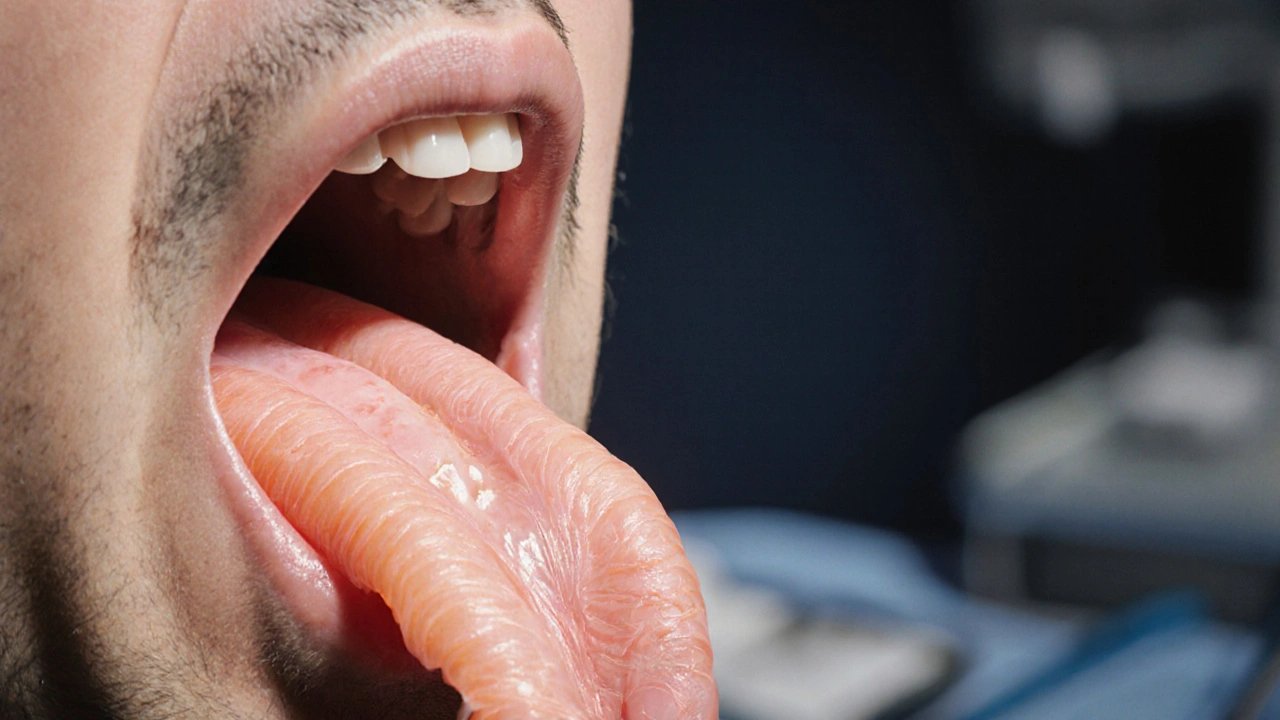Chronic heartburn isn’t just annoying-it can be a warning sign of something more serious. If you’ve had acid reflux for more than five years, especially if it happens several times a week, your esophagus may be changing in ways you can’t see or feel. That change is called Barrett’s esophagus, and it’s the body’s attempt to heal itself after years of stomach acid burning the lining. But this healing comes with a hidden risk: it can lead to esophageal cancer.
What Exactly Is Barrett’s Esophagus?
Barrett’s esophagus happens when the normal tissue lining your esophagus-soft, pink, and made of squamous cells-gets replaced by a different kind of tissue: columnar cells that look more like the lining of your intestine. This is called intestinal metaplasia. It was first identified in 1950 by British pathologist Norman Barrett, and since then, we’ve learned it’s not just a change in appearance-it’s a biological shift that increases cancer risk.This isn’t something that happens overnight. It takes at least 10 years of regular acid reflux for the damage to accumulate enough to trigger this transformation. About 5.6% of people in the U.S. have Barrett’s esophagus, but among those with long-term GERD, the rate jumps to 10-15%. Men are three times more likely to develop it than women, and White men over 50 with a history of smoking or obesity face the highest risk.
The scary part? Barrett’s esophagus doesn’t cause new symptoms. If you’re already dealing with heartburn, regurgitation, trouble swallowing, or chest pain, you might assume those are just part of living with GERD. But those same symptoms are often the only clues you have. There’s no blood test, no scan, no simple way to detect it without an endoscopy.
How Is It Diagnosed?
Diagnosis requires an upper endoscopy-a thin, flexible tube with a camera is passed down your throat to look at your esophagus. If the lining looks unusually salmon-colored instead of pale pink, doctors suspect Barrett’s. But color alone isn’t enough. They take small tissue samples-usually 12 to 24 biopsies-using the Seattle protocol, which means sampling every 1 to 2 centimeters along the affected area.These samples are reviewed by a pathologist to confirm intestinal metaplasia. Once confirmed, the condition is graded based on whether abnormal cells (dysplasia) are present:
- Non-dysplastic Barrett’s esophagus (NDBE): No precancerous changes. Most common.
- Indefinite for dysplasia: Changes are unclear. Needs follow-up.
- Low-grade dysplasia (LGD): Mild cell abnormalities. Higher risk.
- High-grade dysplasia (HGD): Severe abnormalities. Close to cancer.
High-grade dysplasia carries a 6-19% chance of turning into cancer each year. That’s why catching it early matters.
Who Should Be Screened?
Not everyone with heartburn needs an endoscopy. Screening isn’t recommended for people with occasional reflux. But if you’re a man over 50 with chronic GERD-meaning symptoms at least three times a week for more than five years-and you have one or more of these risk factors, screening is advised:- White race
- Obesity (especially belly fat)
- Smoking history
- Family history of Barrett’s or esophageal cancer
Women and younger men without these risk factors are generally not screened because the risk is low enough that the cost and potential risks of endoscopy outweigh the benefits. But if you’re a woman with long-term GERD and multiple risk factors, talk to your doctor. Guidelines aren’t one-size-fits-all.
Here’s the hard truth: most people don’t get screened until it’s too late. Studies show 68% of patients had symptoms for over five years before being diagnosed. Many thought their heartburn was just ‘bad indigestion’ and didn’t seek help. Others saw doctors who didn’t recognize the need for endoscopy.

What Happens After Diagnosis?
If you’re diagnosed with non-dysplastic Barrett’s esophagus, your main goal is to stop the acid from causing more damage. That means:- High-dose proton pump inhibitors (PPIs), like omeprazole 40mg twice daily
- Weight loss-aim for a BMI under 25
- Avoiding trigger foods: caffeine, chocolate, fatty meals, spicy food
- Not eating within three hours of bedtime
- Elevating the head of your bed by 6-8 inches
But here’s something many don’t realize: controlling your heartburn doesn’t always mean you’ve stopped the acid from damaging your esophagus. Studies using pH monitors show that even when symptoms improve, acid reflux can still be happening. That’s why symptom relief ≠ tissue protection.
For surveillance, the American College of Gastroenterology recommends:
- NDBE: Endoscopy every 3-5 years
- LGD: Confirm with a second pathologist, then endoscopy every 6-12 months
- HGD: Don’t wait-treat it
For high-grade dysplasia, endoscopic treatments are now standard. Radiofrequency ablation (RFA) uses heat to destroy the abnormal tissue. Cryotherapy uses freezing. Both have success rates of 90-98% in eliminating dysplasia. Many patients are cured within months. One patient at Mayo Clinic had HGD cleared after six months of RFA and hasn’t had a recurrence in five years.
The Big Problem: Too Many Unnecessary Procedures
Only about 5% of people with Barrett’s esophagus ever develop cancer. That means 95% of those undergoing regular endoscopies are being monitored for a risk that won’t happen to them. Each endoscopy carries small risks-bleeding, perforation, sedation complications-and costs hundreds to thousands of pounds. In the U.S., over $1.2 billion is spent annually on Barrett’s surveillance.Doctors are now trying to find better ways to tell who’s truly at risk. New tools like the TissueCypher Barrett’s Esophagus Assay analyze tissue for molecular markers that predict cancer progression. In a 2021 study, it had a 96% negative predictive value-meaning if the test says low risk, you’re very unlikely to develop cancer in the next three years. Medicare now covers it.
Another promising area is DNA methylation testing. A $2.4 million study in Texas (2023-2026) is testing whether certain gene changes can identify the small group of patients who need aggressive monitoring-and spare the rest from endless scopes.

What You Can Do Now
If you’ve had daily heartburn for over five years, especially if you’re a man over 50, overweight, or a smoker:- Don’t wait for symptoms to get worse.
- Ask your GP for a referral to a gastroenterologist.
- Get an endoscopy if recommended.
- Start lifestyle changes now-even if you’re not diagnosed.
Even if you’re diagnosed with non-dysplastic Barrett’s, you’re not powerless. Lifestyle changes can reduce your risk of progression. Weight loss alone can cut acid reflux by half. Quitting smoking reduces cancer risk by 40% over five years.
And if you’re already on PPIs, don’t assume they’re doing everything. Ask your doctor about 24-hour pH monitoring. It’s the only way to know if your medication is truly suppressing acid-not just masking symptoms.
Final Thought: Knowledge Is Protection
Barrett’s esophagus is silent until it’s not. By the time cancer shows up, survival rates drop below 20%. But if caught early-before dysplasia, or even with low-grade changes-most people can avoid cancer entirely.It’s not about fear. It’s about awareness. If you’ve lived with chronic GERD for years, you’ve already paid the price in discomfort. Don’t let the next step be a diagnosis of cancer. Ask for screening. Make the changes. Take control before it’s too late.
Can Barrett’s esophagus go away on its own?
Barrett’s esophagus doesn’t typically disappear without treatment. However, in some cases, especially after successful endoscopic ablation like radiofrequency ablation, the abnormal tissue can be completely removed and replaced with normal esophageal lining. This is called regression. But even after regression, ongoing surveillance is usually recommended because the underlying GERD hasn’t gone away.
Do proton pump inhibitors (PPIs) prevent cancer in Barrett’s esophagus?
PPIs help control acid reflux and may slow the progression of Barrett’s esophagus, but they don’t eliminate cancer risk. Studies show PPIs reduce inflammation and may lower the chance of developing dysplasia, but they don’t reverse existing changes. The key is complete acid suppression-not just symptom relief. Some patients still have acid exposure despite taking PPIs, which is why pH monitoring is important.
Is Barrett’s esophagus hereditary?
There’s no single gene that causes Barrett’s esophagus, but family history does increase risk. If a close relative has Barrett’s or esophageal adenocarcinoma, your risk is higher. This may be due to shared genetics, lifestyle, or eating habits. If you have a family history and chronic GERD, discuss earlier screening with your doctor.
Can I still drink alcohol with Barrett’s esophagus?
Alcohol, especially wine and spirits, can relax the lower esophageal sphincter and increase acid reflux. While moderate drinking may not be strictly forbidden, heavy alcohol use is linked to higher cancer risk. Most experts recommend limiting or avoiding alcohol entirely if you have Barrett’s esophagus, particularly if you’re also a smoker or overweight.
How often do I need an endoscopy if I have Barrett’s esophagus?
It depends on the level of dysplasia. For non-dysplastic Barrett’s, endoscopy every 3-5 years is standard. If low-grade dysplasia is found, you’ll need a second opinion from a specialist and repeat endoscopy in 6-12 months. High-grade dysplasia usually means treatment, not surveillance. Always follow your doctor’s plan, but don’t hesitate to ask why a certain interval was chosen.
Are there alternatives to endoscopy for screening?
Yes, but they’re not yet standard. The TissueCypher test analyzes tissue samples for molecular markers and can help rule out high risk with 96% accuracy. Capsule endoscopy devices are being tested, but they can’t take biopsies. Blood tests and breath tests are still experimental. For now, endoscopy with biopsy remains the gold standard-but new non-invasive tools are coming fast.




Erika Lukacs
November 16, 2025 AT 23:50It’s wild how the body tries to protect itself by turning one kind of tissue into another, but in doing so, it accidentally builds a runway for cancer. We think healing is good, but sometimes it’s just evolution playing Russian roulette with our organs.
Barrett’s isn’t a disease-it’s a silent negotiation between your esophagus and your stomach acid, and the esophagus lost the first round decades ago.
Rebekah Kryger
November 17, 2025 AT 16:52Let’s be real-this whole screening paradigm is a profit-driven circus. Endoscopies are expensive, PPIs are billion-dollar drugs, and the real risk? Probably overblown. I’ve had GERD for 12 years. No dysplasia. No cancer. Just a guy who eats too much pizza and sleeps on his back. The stats are cherry-picked to justify surveillance capitalism.
Also, ‘White men over 50’? That’s not a medical risk group-that’s a demographic for billing codes.
Victoria Short
November 18, 2025 AT 06:00I’ve had heartburn since college. Still haven’t gotten the endoscopy. Maybe next year. Or maybe never. I’m just tired of doctors making me feel guilty about my lifestyle.
Eric Gregorich
November 18, 2025 AT 16:02Think about it: your esophagus is basically a biological refugee camp. For years, acid rains down like napalm, and the tissue-desperate, starving, terrified-replaces itself with something that looks like intestine because that’s the only thing that can survive the bombardment. It’s not healing. It’s surrender.
And then we call it ‘metaplasia’ like it’s some elegant biological adaptation, when really, it’s just a body giving up and trying to look like something else so the pain stops. We’ve all done it. We’ve all become something we’re not just to survive. We just don’t usually call it ‘intestinal metaplasia’ when it’s our souls.
And the worst part? The system doesn’t care if you’re suffering. It cares if you’re in the 5.6%. It cares if you’re a White man over 50. It cares if you’re on Medicare. It doesn’t care that you’ve been swallowing omeprazole like candy because your throat burns every morning and you’re too afraid to ask if it’s doing anything at all.
So you get screened. You get biopsied. You get told to lose weight, stop smoking, sleep upright, avoid chocolate, caffeine, wine, spicy food, late dinners, stress, and your own damn existence. And still-you’re not sure if any of it matters. Because the truth? The acid is still there. And so are you. And the cancer? It’s just waiting. Quietly. Patiently. Like a landlord who knows you can’t afford to move out.
Koltin Hammer
November 20, 2025 AT 12:03There’s something deeply human about how we ignore our bodies until they scream. We treat GERD like a nuisance-like a leaky faucet you can live with until the ceiling collapses.
But Barrett’s? That’s the quiet kind of betrayal. No fever. No rash. No broken bone. Just a slow rewrite of your own biology, and you don’t even know it’s happening until someone with a camera and a biopsy forceps shows you the evidence.
And then we get mad at the system for being expensive, but we never ask why we waited so long to look. We’re all guilty of that. We wait for the crash before we check the engine.
Still, I’m glad these new molecular tests are coming. We’ve been doing this the hard way for too long. A $2.4 million DNA methylation study? That’s not just science-that’s justice for the people who didn’t know they were at risk because they weren’t a ‘high-risk demographic.’
And honestly? If I were a woman with GERD and a family history, I’d push harder. Guidelines are written by committees. Your body doesn’t read guidelines. It just reacts.
Phil Best
November 20, 2025 AT 22:48Let me get this straight: you’re telling me I need to spend $1,200 every three years to get a camera shoved down my throat… just because I like pizza and wine and sleep like a corpse?
And if I do it, I might get ‘low-grade dysplasia’-which sounds like a bad Yelp review for my esophagus-and then I have to do it again in six months?
Meanwhile, my cousin in India is drinking chai with his meals at midnight, smoking a bidi, and eating curry with his hands… and he’s 72 and still hiking.
Maybe the real problem isn’t Barrett’s.
Maybe it’s that we’ve turned our bodies into insurance fraud investigations.
Just sayin’.
Parv Trivedi
November 22, 2025 AT 11:33As someone from India where spicy food is daily life and GERD is common, I’ve seen many people ignore symptoms until it’s too late. But I also know people who changed their diet, lost weight, and never needed an endoscopy.
It’s not about fear. It’s about awareness. And yes, access matters. Not everyone can afford an endoscopy. But even small changes-like not eating before bed or reducing oil-can make a big difference.
Let’s not make this a Western-only conversation. The body reacts the same everywhere. The difference is in how we listen.
Willie Randle
November 22, 2025 AT 19:33One correction: the Seattle protocol requires sampling every 2 cm, not every 1–2 cm. Also, ‘non-dysplastic Barrett’s esophagus’ should be abbreviated as NDBE on first use, not just thrown in without definition. These details matter when people are making life-altering medical decisions.
That said, this is one of the clearest, most responsible explainers I’ve read on the topic. Thank you for emphasizing that symptom control ≠ tissue protection. Too many patients assume PPIs are a cure. They’re not. They’re a bandage. And bandages don’t fix broken bones.
Connor Moizer
November 23, 2025 AT 11:01You’re not ‘at risk’ if you’re not doing anything about it. That’s the bottom line.
If you’ve had GERD for five years and you haven’t changed your lifestyle, you’re not ‘waiting for symptoms to get worse’-you’re waiting for cancer to show up.
Stop being passive. Stop blaming the system. Stop hoping PPIs are magic. Lose the weight. Quit smoking. Stop eating at 11 p.m. Elevate your bed. Drink water. Move your body.
If you’re too lazy to do that, then yes, you deserve the endoscopy. And yes, you deserve the cost. Because this isn’t a mystery. It’s a choice. And you’ve already made it.
Now stop reading Reddit and go to your doctor.
kanishetti anusha
November 24, 2025 AT 22:35I’ve been on PPIs for 8 years. I thought I was fine because I didn’t feel heartburn anymore. But last year, I asked for a pH test-and turns out, I was still getting acid exposure 4 hours a day. That’s when I realized: feeling okay doesn’t mean your body is okay.
I started sleeping on a wedge pillow, stopped eating after 7 p.m., and lost 15 pounds. My last endoscopy showed no dysplasia. I’m not cured-but I’m fighting. And that’s enough.
To anyone reading this: if you’re on PPIs, ask for the pH test. It’s not expensive. It’s not scary. It’s just… the truth.
roy bradfield
November 25, 2025 AT 19:49Let’s be honest-Barrett’s esophagus is just the tip of the iceberg. Big Pharma doesn’t want you to know that acid reflux is caused by low stomach acid, not too much. They want you on PPIs forever because they make billions. The whole ‘intestinal metaplasia’ thing? It’s a distraction. The real enemy? Glyphosate in your food. EMF radiation from your phone. The government’s hidden agenda to keep you docile and dependent on drugs.
They’ll tell you to get an endoscopy. But what if the camera is just a tool to make you believe the lie? What if the ‘biopsies’ are planted? What if the ‘cancer risk’ is inflated to justify the surveillance state?
I’ve stopped taking PPIs. I drink apple cider vinegar. I sleep on the floor. My esophagus is healing. The system hates that. That’s why they keep pushing endoscopies.
Wake up.
Patrick Merk
November 26, 2025 AT 02:55Man, this post hit different. I’ve got a mate who had HGD last year-got RFA, now he’s cancer-free and actually eats dinner without fear for the first time in 20 years.
But here’s the thing: he almost didn’t go. Thought it was ‘just heartburn.’ His GP told him to ‘take an antacid and call back if it gets worse.’
So yeah-awareness saves lives. But so does pushing back when doctors are lazy. Ask for the endoscopy. Ask for the pH test. Ask for the second opinion.
And if you’re a woman with GERD? Don’t let anyone tell you you’re ‘low risk.’ Your body doesn’t care about gender stats. It just wants you to listen.